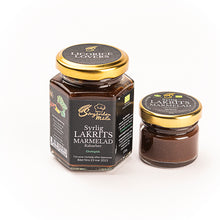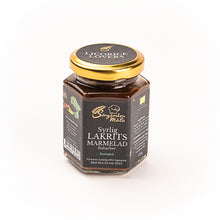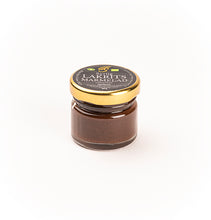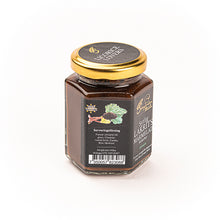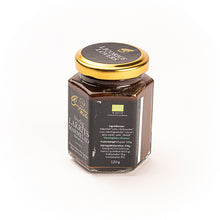
A wonderfully healthy, sweet and tart jam on rhubarb with a clear licorice flavor and notes of real vanilla. It is delicious on ice cream, but tastes just as good on many different cheeses, both mild cheeses, Cheddar and cream cheese, as well as more flavorful, blue cheese and Gruyère.
Licorice has long been a flavor for the adventurous. I have always been a licorice aficionado. Here I have allowed the ripe and sweet taste to marry with sour rhubarb. The result is a sour, fresh taste sensation, quite simply!
Perfect for ice cream, Cheddar, toast, Gruyère, Danbo, Brie, cream cheese, blue cheese
The word licorice comes from the Greek word 'glukurrhiza' which means sweet root. Not only does this magical plant have 50 times the natural sweetness of refined sugar without the calories, it is also an herb known for its soothing and calming properties. Growing in sandy soil, its creeping roots spread in all directions, drawing nutrients deep into the soil. It is traditionally known and used as medicine in Ayurveda for rejuvenation.
At Sörgården Måla, we only use licorice made from whole roots of certified organic licorice that meet the highest quality standards. Our licorice comes from Calabria in Italy, which helps ensure the sustainable use of our ingredients.
A bit like the effect of adding a pinch of salt to food to bring out the best flavors, licorice also makes a recipe more effective. Thanks to this unique quality, it is considered to increase the power of the synergy between different ingredients in a mixture and is used to harmonize different flavors.
Rhubarb goes well with food, in the past you ate rhubarb the same way we eat spring primroses today: raw with a little salt and pepper! And rhubarb's sour taste is excellent in cooking, for example as a chutney for fattier fish, pork and duck or in a Persian lamb stew. On the Danish island of Bornholm, smoked herring with rhubarb compote is a traditional dish.
Rhubarb (Rheum rhabarbarum) is a perennial and easy-care plant that can be grown in most of Sweden - but it takes a few years before it yields an abundant harvest. Once established, however, it only gives more and more. Rhubarb's flowering stems can grow up to two meters tall and have fluffy, branched inflorescences with small creamy white flowers. Otherwise, rhubarb's hallmark is the crunchy, sour and, well, scraggy stems, which are fantastically good in pie, juice, jam, marmalade and many desserts.
Rhubarb was cultivated in China as early as 3,000 years before our era, mainly as a medicinal plant. It first came to Europe in the 17th century and to Sweden as late as the 19th century.
Rhubarb is a vegetable, but sold as a fruit. The special, sour taste comes mainly from malic acid. The roughness comes from oxalic acid and varies between different varieties.
There are over 100 varieties of rhubarb with different color, taste and roughness. Victoria with greenish flesh is one of the most common. Rosenhagen, spangsbjerg, elmsfeuer and elmblitz are slightly milder, less rough rhubarb varieties with a beautiful rose-red colour.
When the lilac blooms at the end of May, it is rhubarb time. Rhubarb can be harvested from the end of April and a bit into August. At the beginning of the season, the stems are at their best and rarely need to be peeled. The further into the season, the coarser the fibers and the woodier the taste.
Rhubarb's leaves contain a high content of oxalic acid, which can be dangerous to health. Large amounts of oxalic acid can be negative for the body as it can reduce the absorption of important minerals such as calcium. In the worst case, it can cause kidney damage.
Harvested rhubarb can be stored in the refrigerator for about a week, or you can cut it into pieces and freeze in suitable portion bags.
Rhubarb should be boiled briefly, in order to preserve maximum color and flavor, we cook the marmalade over an open flame, which provides quick cooking.
Ingredients : Rhubarb (64%), raw cane sugar (31%), licorice granules, lemon, real vanilla, anise seed, fennel seed
Nutrition declaration 100g: Energy 612 kJ/142 kcal; Fat 0.1 g (saturated fat 0 g); Carbohydrates 35 g (sugars 35); Protein 0.9 g; Salt 0.03 g





